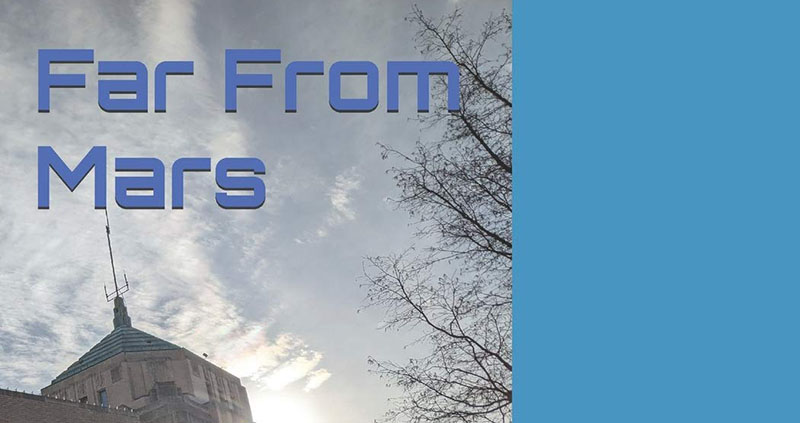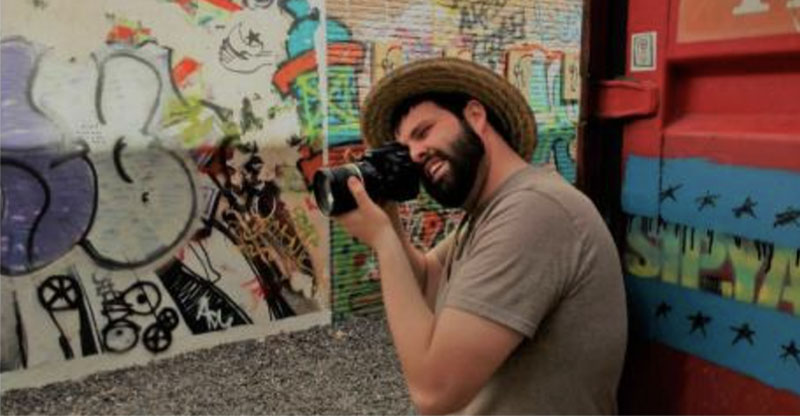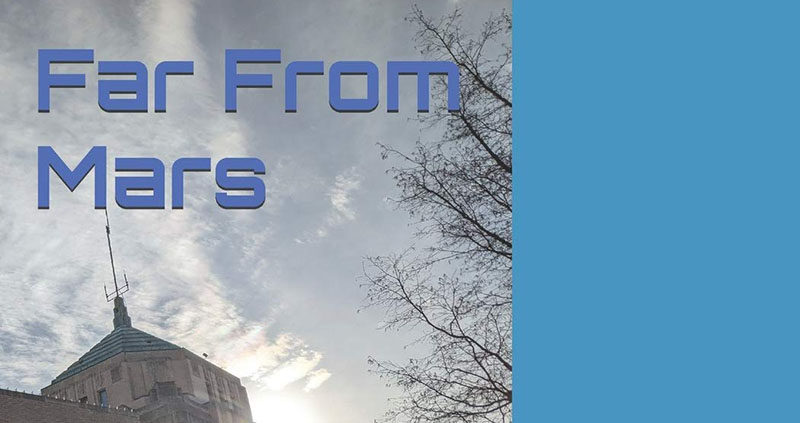Part love letter, part portrait of a young man as journalism student, Sal Nudo’s Far From Mars: Nine Creative Nonfiction Stories Featuring People and Places in Champaign-Urbana deserves a place on your reading list. Though Far From Mars offers a very different aspect of the author’s range than in his gripping thrilling, The Millionaire’s Cross , which was reviewed here almost a year ago, one thing remains constant: Nudo sure knows how to tell a good story.
The collection includes pieces written during Nudo’s time as a journalism grad student at the Illinois College of Media. And, I,m proud to say, several of them appeared here, in Smile Politely, first. The ninth and final story, “The Man Who Lives to Help,” won third place in the 2015 Marian and Barney Brody Creative Feature Article Award in Journalism. This outstanding example of immersion journalism (more about that sub-genre later) demonstrates not only his keen observation and listening skills, and his near poetic framing, but also his patience, his compassion, and his contagious sense of optimism.
In the book’s forward, Nudo shares that Far From Mars is his way of “putting a little chink in that armor of journalism, with the hope that literary journalism and immersion journalism become more prominent.” He “gave this book the same title as story number eight because [he believes the articles] are light years away from the typical journalism pieces seen online and in newspapers. They offer a break from politics, celebrities, world strife, lawsuits and a million other news and entertainment items that bombard us daily— stories that come from Mars because they are worlds away from the average person.”
Okay. I guess i’s time to address the elephant in the room: What exactly is literary journalism/creative nonfiction? it is generally agreed upon that the genre blends the factual information of traditional journalism with the artistry and narrative framing of literature. Some say it is a close relative of the essay; while others have with a distant, Ancestor.com-style connection to memoir and biography. One thing is for certain. It requires a rare mix of skills and sensibilities, a form of alchemy, or an alchemy of forms, that Nudo has clearly mastered.
Each story is framed by a short author blurb which provides context and a deeper understanding of the work to follow. Ahead of the title story, he writes:
“The book’s title, Far From Mars is also the partial title of the eighth story within these pages. In that piece, “Mars” refers to a Bruno Mars concert I attended the night before writing an article about 217 Float in Champaign. Being “far away from Mars” in that narrative described the feeling I had while soaking and drifting away in a pod… filled with saltwater—an ecosystem away from a loud concert.”
Though the collection can easily be enjoyed by any fan of the genre. It will hold a special significance for C-U readers. Nudo wrote that “the Midwesterners [in] Far From Mars are regular people who took chances, followed their passions, and pursued meaningful hobbies.” And I’ll bet that you already know some of them. But, as is especially the case in a small college town, people are multi-faceted, they live in multiple worlds playing a variety of roles. You may know them, but you may not know their real stories, the best parts of them, their passions, and the risks they take for them. These are gems that Nudo’s style and format mine. While I won’t name names, at least not all of them, I will share that Far From Mars, spends a good amount of time exploring C-U radio, food, C-U music. and food.
For this reader, the work as a whole speaks to the notion of happy accidents. When things go sideways, as they often do when pursuing a story, Nudo sees that fork in the road as a gift and an opportunity to learn something new. His enthusiasm is clearly evident. It evokes a time of road trips, just walking around and seeing what happens, and taking to strangers that which sadly feels bittersweet and nostalgic in COVID times.

Image by Sal Nudo.
Nudo’s willingness to go with the flow yields fantastic results in both Story One, “Dog Devotion,” the posting of an incorrect meeting time leads to a deep dive into the world of rescue Greyhounds, and Story Three, “Sam’s Hobby.” where Nudo shares “It was fun driving around with Sam during his quest to meld images from widely spaced eras of the twin cities. This project never amounted to anything for Sam—the pictures he took were never published or promoted anywhere—but it was far from a wasted afternoon, at least for me. I observed an artists in motion, and I got a story out of it.”
Take a read for yourself:
“It’s a picture-perfect late-afternoon Sunday in early June, and Sipyard is the location for a laid-back “self-love photo shoot,” as labeled and organized by Smile Politely photographer Tom Chandler. Sam, who does his best to support the community of photographers in Champaign-Urbana, hurries back toward Tom, his hat now covering short brown hair and shadowing a thick beard. The vibrant graffiti lines the alleyway on both sides, and Sam takes his time choosing where he would like to station his six-foot-two, 218-pound frame, as if envisioning himself on the other side of the lens as the photo taker. The camera clicks begin and don’t stop for about a minute. Sam asks Tom to take a photo of him taking a photo, perhaps an esteemed sort of image among this artsy, photo-loving crowd. Soon a circle forms and everyone, armed with their devices, starts taking photos of everyone. It feels like a kumbaya moment with cameras, with only the whirring of clicks to indicate the celebration.”

Photo by Sal Nudo.
And now, ending where we began, with the award-winning example of immersion journalism, Story Nine, “The Man Who Lives to Help.” Immersion journalism requires a writer to immerse themself in the lives of their subjects. And over time, it yields the story of the writer’s specific experiences. Fans of the sub-genre claim that “this research strategy allows authors to describe the internal experience of external events and break away from the limiting pseudo-objectivity of traditional journalism.” It is perhaps the most challenging approach for a writer, but, as you’ll discover when you read it, the most suited to capturing the period of time Nudo spent sharing Postlewaite’s life.
“At 5-foot-7-inches tall and not a bit of fat on his bones, Louis offers a fascinating look at life’s contrasts: He is a hardened criminal who also possesses a harmless quality and is genuinely nice; an uneducated man who likes to read and takes an interest in different topics; a hard worker who has been fired from jobs and has experienced homlessness; and someone who bounced around Peoria’s ‘projects’ as an adult but who grew up in a two-story house in Battle Creek, Michigan, and saw firsthand the burgeoning success of a future classic Motown band.” And he observes later in the story, “Apparently even in his worst days. Louis Postlewaite was a likeable guy.”
“Because of his intense drinking, Louis couldn’t hold down food. He said God saved his life once by sending him to prison for a two-and-and-a-half year stint. “That was enough to get me on the right track,” he said. “The nurses even told me if I had stayed out there doin’ what I was doin’, I’d probably be dead now.”
If I have one critique it is that what I read left me wanted more of it. Perhaps we can convince Sal Nudo to explore a second edition.
Far From Mars: Nine Creative Nonfiction Stories Featuring People and Places in Champaign-Urbana is available in paperback and e-book on Amazon, where you can also follow Nudo’s author page.








